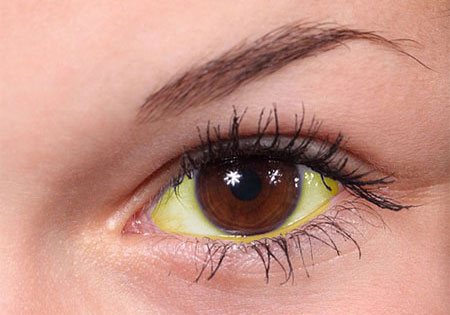Causes, Symptoms, Diagnoses, Prevention and Cure of Jaundice
What is Jaundice?
Repair and rejuvenation is a constantly occurring process in the human body as new cells and tissues are created and older ones broken down in order to keep the body in a healthy condition. The Red Blood Cells (RBC) in the human body are also subject to this process.

What are the symptoms?
Jaundice is one of the most easily-recognizable or detectable ailment due to its prominent symptoms. Typical symptoms include a yellowish hue to the skin and the whites of the eyes, and can be present all over the body. Other symptoms include Pruritis or itchiness, Fatigue, stomach pain, weight loss, Fever, Vomiting, light-colored stools and dark-colored urine.
Why does it occur?
There are a few conditions or disorders which are known to trigger jaundice. When these conditions are present, either bilirubin is produced excessively or the liver is prevented from disposing it off in a routine manner. As a result, the bilirubin gets deposited in various tissues of the body.
Types of Jaundice
Depending on what is preventing the smooth and efficient disposal of bilirubin out of the body, there are 3 types of jaundice.
A. Pre-hepatic Jaundice: In this type, an underlying disorder or infection accelerates the breakdown of RBCs. This causes bilirubin levels in the blood to increase. The triggering disorder could be any of these:
- Malaria: An infection that is spread from one person to another when the female anopheles mosquito, which carries the plasmodium parasite, bites these individuals
- Sickle-cell anaemia: A genetic disorder where the RBCs develop abnormally; it’s most common among people of African descent
- Thalassaemia: Another genetic disorder which causes abnormal form of haemoglobin and excessive destruction of RBCs; most common in people of Mediterranean, Middle Eastern and South-Asian descent
- Crigler-Najjar syndrome: A genetic disorder where an enzyme required to transport bilirubin out of the blood and into the liver is missing
- Hereditary spherocytosis: A genetic disorder which causes RBCs to have an abnormally short life-span
B. Intra-hepatic Jaundice: In this condition, any damage to the liver due to infections or alcohol interferes with the liver’s ability to produce or process bilirubin. The damage in the liver could be due to any of these:
- All classes of Viral hepatitis infections – hepatitis A, B and C
- Cirrhosis: where the liver is damaged due to alcohol abuse
- Leptospirosis: A bacterial infection where animals such as rats are the carriers
- Glandular fever: A viral infection, also known as infectious mononucleosis, caused by the Epstein-Barr virus
- Drug abuse: Abuse of either psychedelic drugs like ecstasy or overdose of OTC drugs such as paracetamol
- Primary biliary cirrhosis: A rare ailment where the liver get damaged progressively
- Gilbert’s syndrome: A genetic disorder where the liver is not able to break down bilirubin at a normal rate
- Liver cancer: A rare and incurable form of cancer that is fatal most often
- Exposure to harmful chemicals: Phenol that is used in the manufacture of plastic, and carbon tetrachloride that was once used in refrigeration are some chemicals that can damage the liver rapidly
- Autoimmune hepatitis: A rare disorder where the body’s immune system begins to attack the liver
- Primary sclerosing cholangitis: A rare disorder where the liver is chronically inflamed all the time
- Dubin-Johnson syndrome: A genetic disorder where the liver is unable to move bilirubin out of the liver
C. Post-hepatic Jaundice: In this type, the bile duct system is damaged, inflamed or obstructed, which results in the gall bladder being unable to move bile into the digestive system, thereby triggering jaundice. The triggering conditions include:
- Gall stones: Stones in the gall bladder which obstruct the bile duct system
- Cancer of the Pancreas, gall bladder or bile duct
- Pancreatitis: Here the pancreas get inflamed and this can be either acute that lasts for a few days, or chronic which lasts for many years
Diagnosing Jaundice
An evaluation of the patient’s medical history and a detailed physical examination of the abdomen are the preliminary measures to detect or confirm jaundice. Thereafter, various tests are conducted to gauge the severity of jaundice and understand the triggering condition. Some of these tests and procedures are:
- Liver function test which gives an idea of the bilirubin levels
- Blood test to get the complete blood count (CBC)
- Hepatitis A, B, and C tests to rule out or detect the condition
- Imaging procedures to assess if there is any structural damage to the liver or any obstruction in the liver; these could be Abdominal ultrasonography (ultrasound) /CT or MRI scan /Endoscopic retrograde cholangiopancreatography (ERCP)
- Liver biopsy if any inflammation, cirrhosis, cancer, or fatty liver is suspected
Treating Jaundice
Treating jaundice involves diagnosing the triggering cause and treating it accordingly.
- Anemia-induced jaundice: This requires increasing the amount of iron in the blood; either organically by consuming iron-rich food, or inorganically by taking iron supplements
- Hepatitis-induced jaundice: This is treated through anti-viral or steroidal medications
- Obstruction-induced jaundice: Here, surgery is the only option to remove the obstruction
- Medication-induced jaundice: This is treated by discontinuing the drugs that caused jaundice, and prescribing alternative medicines
Preventing Jaundice
Jaundice is concerned with the liver’s functionality, so people must take care to maintain liver health. This includes but is not limited to
- Diet: Eat a balanced diet that is rich in fibre, fruits, vegetables and whole grain. Reduce intake of processed or junk food. Avoid contaminated or unhealthy food such as from street-side vendors and ill-maintained eateries
- Exercise: Exercise regularly which helps improve metabolism and stimulate the liver
- Alcohol: Show restraint in the consumption of alcohol
- Blood transfusion: Take extreme care in times of blood transfusion. Ensure clean and hygienic practices are followed and the hospital is a clean and reputed one
- Unhealthy habits: Avoid use of psychelic drugs, or using syringes and needles used by others

Article by Dr. Kannan. D., M.S, M.CH(GASTRO), FRCS(GLASG)
Surgical Gastroenterologist
Kauvery Hospital

